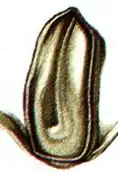Funnel–mantle locking apparatus
The funnel–mantle locking apparatus is a structure found in many cephalopods that connects the mantle and hyponome (funnel) and restricts their movement relative to each other.[1] It consists of two interlocking components: one located on the mantle (often fibrous) and the other on the funnel (often cartilaginous).[1] The apparatus may permit some anterior–posterior displacement or prevent movement altogether.[1]

Funnel–mantle locking apparatus of a juvenile male Argonauta hians
Function
Variability
Funnel component
Six major forms of the funnel locking apparatus are recognised among teuthids (lazy-T shape, inverted-T shape, straight shape, triangular shape, oval with tragus and/or antitragus, and oval shape) and several more are found in the sepioids (including the boomerang shape and keyhole shape).[2]
| Shape of funnel locking apparatus | Species | Family |
|---|---|---|
 |
Idioteuthis cordiformis | Mastigoteuthidae |
 |
Magnapinna talismani | Magnapinnidae |
 |
Mastigoteuthis flammea | Mastigoteuthidae |
 |
Mastigoteuthis glaukopis | Mastigoteuthidae |
 |
Mastigoteuthis grimaldii | Mastigoteuthidae |
 |
Mastigoteuthis magna | Mastigoteuthidae |
Mantle component
| Shape of mantle locking apparatus | Species | Family |
|---|---|---|
 |
Mastigoteuthis grimaldii | Mastigoteuthidae |
References
- Young, R.E., M. Vecchione & K.M. Mangold (1999). Cephalopoda Glossary. Tree of Life Web Project.
- Young, R.E., M. Vecchione & K.M. Mangold (1997). Cephalopod Funnel Locking-Apparatus. Tree of Life Web Project.
This article is issued from Wikipedia. The text is licensed under Creative Commons - Attribution - Sharealike. Additional terms may apply for the media files.


